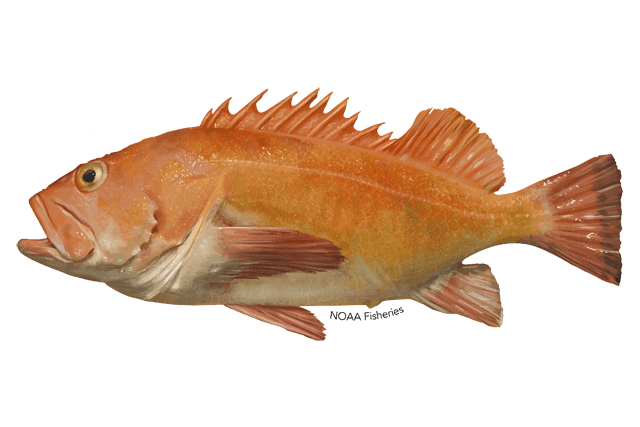Yelloweye Rockfish

Species Details
Sebastes Ruberrimus
Sebastidae
Scorpaeniformes
offshore
5 - 39 lbs.
16" - 41"
Yelloweye Rockfish (Sebastes ruberrimus) Fish Description
As the name suggests, the Yelloweye Rockfish (Sebastes ruberrimus), got its name from its distinctive yellow eye. Aside from its colorful eye, one of the most distinguishing features of this fish species is its brightly colored body, which changes as it matures. From the deep reddish hue when it’s still in its youth, it changes to a brighter orange as it reaches adulthood, and until finally to deeper yellow at the latter part of its life. While many anglers call it red snapper, it’s not actually related in any way to the “true” red snapper found in the Gulf of Mexico.
The Yelloweye Rockfish is one of the biggest in its genus Sebastes as it’s been known to grow up to three feet and can weigh up to twenty-four pounds. It’s also known for its long lifespan that’s been said to reach up to one hundred and thirty years.
The Yelloweye Rockfish usually mates in November. The females can produce from 1.2 to 2.7 million eggs every year and can store sperm for months before fertilizing the eggs. Gestation can last for about one to two months and gives birth to live babies between April and September. When the babies are born, they would spend six to nine months living in the open ocean until they are big enough to swim to the bottom where they would stay for years—in the shallow areas at first, then would migrate to the deeper parts of the ocean as they age.
Interesting Facts About Yelloweye Rockfish
- The biggest Yelloweye Rockfish caught on record measures a little over three feet long and weighs thirty-nine pounds.
- The world record fish was caught off the coast of Alaska by deep sea fishers.
- They have one of the longest lifespans among the fishes in the ocean.
- They are said to live to a maximum of 114 to 120 years of age.
- There were unconfirmed reports of Yelloweyes living to one hundred and fifty years.
- Some are known to live their entire life in a single rock pile.
- They are also called red snapper though they are not related to the “true” red snapper found in the Gulf of Mexico.
- They are favorite fishing targets by both commercial and recreational fishers.
- Their meat is highly prized as it’s known for its sweet delicate taste.
- They are often accidentally caught by commercial fishers via trawling.
- Most Yelloweye Rockfish caught often die of temperature shock and/or barotrauma.
- Barotrauma is an injury that happens to a bottom-dweller fish accustomed to the high pressure in the deep waters then suddenly taken to the surface.
- Barotrauma can cause their eyes and stomach to expand and, on occasion, explode.
- There’s a significant decline in the Yelloweye Rockfish population in the early 2000s due to overfishing.
- The fish species was placed under the “threatened list” by the NOAA Fisheries.
- Fishing restrictions were placed by the authorities to help the fish population to recover.
- Commercial and recreational fishing for Yelloweye Rockfish is currently banned in Puget Sound/Georgia Basin in Washington State.
- In other parts, you can still fish for Yelloweye Rockfish although there are still some restrictions such as reductions in the total allowable catch.
Yelloweye Rockfish Average Size
As already mentioned, the Yelloweye Rockfish is one of the biggest rockfish. Average size can range between five to fifteen pounds; although there’s also a high probability of landing a 25-pounder (or even bigger) if you plan on fishing up north.
Where to Find Them - Habitat and Distribution
The Yelloweye Rockfish are typically found along the west coast of North America from up north as the Gulf of Alaska to down south as northern Baja California, Mexico. They are mostly solitary and live deep down from 60 to 1800 feet—the younger ones usually live in the shallower parts and head deeper as they age. They also prefer living in rocky reefs and boulder fields at the bottom of the ocean where they seek shelter as well as hunt for other smaller fish and other bottom-dwelling invertebrates.
Yelloweye Rockfish Fishing Tips
As Yelloweye Rockfish are often found deep down under the water, you will definitely need heavy weights for you to be able to present your baits and jigs. You would also have to consider the fish’s choice of habitat—within rocks and crevices. This means that for you to be able to effectively wrestle the fish out of their underwater protective covering, you will need a stout bottom fishing tackle. As for the bait, you can never go wrong with natural baits, dead or alive. Lastly, heavy metallic jigs are highly recommended.







